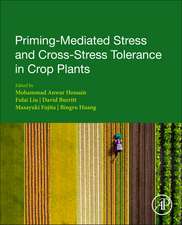Crops and Carbon: Paying Farmers to Combat Climate Change
Autor Mike Robbinsen Limba Engleză Hardback – 9 aug 2011
Previous attention has been focused mainly on reducing emissions from deforestation and land degradation (REDD), but this book is one of the first attempts to examine the potential for carbon sinks in agriculture in crop plants and the soil. In assessing this, the author examines exactly how north-south climate mitigation trading works, or does not, and what the pitfalls are. It highlights the complex relationship between agriculture, particularly different forms of farming systems, and the mitigation of climate change. The arguments are backed up by original research with farmers in Brazil to demonstrate the challenges and prospects which these proposals offer in terms of payments for environmental services from agriculture through carbon trading.
| Toate formatele și edițiile | Preț | Express |
|---|---|---|
| Paperback (1) | 436.14 lei 6-8 săpt. | |
| Taylor & Francis – 10 iun 2019 | 436.14 lei 6-8 săpt. | |
| Hardback (1) | 1013.72 lei 6-8 săpt. | |
| Taylor & Francis – 9 aug 2011 | 1013.72 lei 6-8 săpt. |
Preț: 1013.72 lei
Preț vechi: 1236.25 lei
-18% Nou
193.99€ • 200.43$ • 161.37£
Carte tipărită la comandă
Livrare economică 19 martie-02 aprilie
Specificații
ISBN-10: 1849713758
Pagini: 320
Dimensiuni: 156 x 234 x 28 mm
Greutate: 0.84 kg
Ediția:1
Editura: Taylor & Francis
Colecția Routledge
Locul publicării:Oxford, United Kingdom
Cuprins
Notă biografică
Recenzii
'This book is important - and timely too - as the world begins to realise the connection between climate change, crops, farmers and the soil. Robbins sets out the facts and cogently argues the case for 'cropping carbon'. This book is a must for all who care about the climate, the soil and those who depend directly on agriculture for their livelihoods.' – William Critchley, Head, Sustainable Land Management Unit, VU University Amsterdam, The Netherlands
'Agricultural climate change mitigation urgently needs attention. Robbins' analysis shows the challenges and opportunities of trying to bring together food production and climate change mitigation in the developing world.' – Lini Wollenberg, University of Vermont, USA, and CGIAR Challenge Program on Climate Change, Agriculture and Food Security
'An excellent first step in understanding why carbon management cannot ignore soils and the farming sector.' – Camilla Toulmin (Director, IIED, London) in Agriculture for Development (Spring 2013)
'The book is a welcome addition and one of the first comprehensive attempts to explore issues in the field of soil carbon sinks and climate change. It is rich in information about the linkages between climate change and agriculture including agroforestry. I recommend it as a useful reading for students, researchers, negotiators and policy makers dealing with farmers, agriculture and climate change.' – Seyoum Hameso, Economic Analysis & Policy, Vol. 43 No. 1
'Robbins’ book provides a valuable and comprehensive analysis of the theoretical and practical feasibility of paying farmers to combat climate change. As such it is essential reading to both policy-makers and development practitioners looking to exploit the opportunities that currently exist, or may exist in the future ... It is also accessible reading, assuming neither prior knowledge of climate change, nor of agricultural systems, and begins with chapters reviewing each of these.' – Katharine Vincent, Mitigation and Adaptation Strategies for Global Change
Descriere
Rich countries are paying poor countries to fight climate change on their behalf - and one way they are doing it is through carbon sinks. These are reservoirs of organic carbon tied up in plants and in the earth, rather than being in the atmosphere as greenhouse gases. This book looks critically at this mode of climate change mitigation. Can it work? Is it just? Will poorer countries benefit? The book considers the scientific, economic and ethical basis for this type of mitigation.
Previous attention has been focused mainly on reducing emissions from deforestation and land degradation (REDD), but this book is one of the first attempts to examine the potential for carbon sinks in agriculture in crop plants and the soil. In assessing this, the author examines exactly how north-south climate mitigation trading works, or does not, and what the pitfalls are. It highlights the complex relationship between agriculture, particularly different forms of farming systems, and the mitigation of climate change. The arguments are backed up by original research with farmers in Brazil to demonstrate the challenges and prospects which these proposals offer in terms of payments for environmental services from agriculture through carbon trading.





















